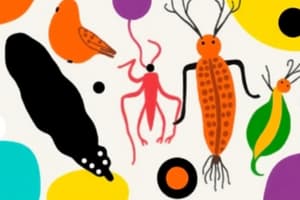Podcast
Questions and Answers
What is the study of the diversity of organisms and their evolutionary relationships?
What is the study of the diversity of organisms and their evolutionary relationships?
What is the primary goal of taxonomy?
What is the primary goal of taxonomy?
What method is used to reconstruct the relationships between different organisms in phylogeny?
What method is used to reconstruct the relationships between different organisms in phylogeny?
What is the process of determining whether an organism belongs to a particular species?
What is the process of determining whether an organism belongs to a particular species?
Signup and view all the answers
What system of classification uses a hierarchical system with the following ranks: Kingdom, Phylum, Class, Order, Family, Genus, Species?
What system of classification uses a hierarchical system with the following ranks: Kingdom, Phylum, Class, Order, Family, Genus, Species?
Signup and view all the answers
What is the term for the two-part naming system used in the Linnaean System?
What is the term for the two-part naming system used in the Linnaean System?
Signup and view all the answers
Study Notes
Biological Classification
Taxonomy
- Study of the classification, identification, and naming of living organisms
- Involves the description, identification, and naming of species
- Goal: to understand the relationships between different organisms
Systematics
- Study of the diversity of organisms and their evolutionary relationships
- Involves the reconstruction of evolutionary history and the classification of organisms based on their shared characteristics
- Includes both taxonomy and phylogeny
Phylogeny
- Study of the evolutionary history of organisms
- Involves the reconstruction of the relationships between different organisms based on their shared characteristics
- Methods: morphological comparison, molecular analysis (e.g. DNA sequencing)
- Goals: to understand the patterns of evolutionary change, to reconstruct the tree of life
Species Identification
- Process of determining whether an organism belongs to a particular species
- Methods: morphological comparison, molecular analysis (e.g. DNA barcoding)
- Importance: accurate species identification is crucial in fields such as ecology, conservation, and medicine
Linnaean System
- System of classification developed by Carolus Linnaeus
- Uses a hierarchical system of classification, with the following ranks:
- Kingdom
- Phylum (or Division in Plantae)
- Class
- Order
- Family
- Genus
- Species
- Uses binomial nomenclature (e.g. Homo sapiens) to identify species
- Still widely used today, with modifications and additions
Biological Classification
Taxonomy
- Defines the classification, identification, and naming of living organisms
- Involves species description, identification, and naming
- Aims to understand relationships between organisms
Systematics
- Examines the diversity of organisms and their evolutionary relationships
- Combines taxonomy and phylogeny to reconstruct evolutionary history
- Classifies organisms based on shared characteristics
Phylogeny
- Reconstructs the evolutionary history of organisms
- Uses morphological comparison and molecular analysis (e.g., DNA sequencing) to study relationships
- Goals: understand evolutionary change patterns and reconstruct the tree of life
Species Identification
- Determines whether an organism belongs to a particular species
- Uses morphological comparison and molecular analysis (e.g., DNA barcoding)
- Accurate identification is crucial in ecology, conservation, and medicine
Linnaean System
- Developed by Carolus Linnaeus, a hierarchical system of classification
- Ranks: Kingdom, Phylum (or Division in Plantae), Class, Order, Family, Genus, Species
- Uses binomial nomenclature (e.g., Homo sapiens) to identify species
- Still widely used today, with modifications and additions
Studying That Suits You
Use AI to generate personalized quizzes and flashcards to suit your learning preferences.
Description
This quiz covers the basics of biological classification, including taxonomy and systematics, and how they are used to understand the relationships between different organisms.




